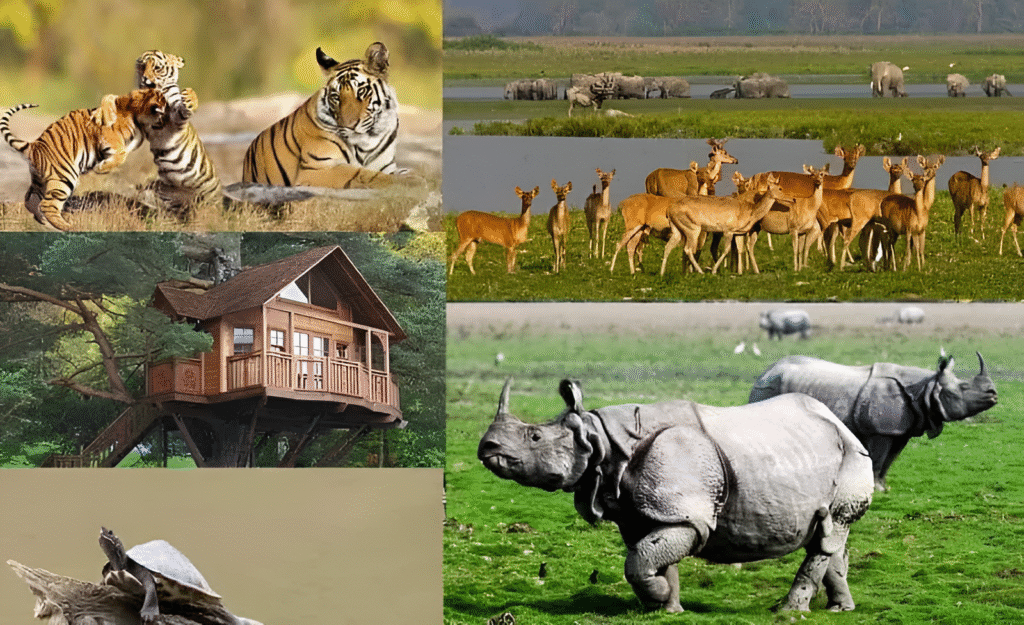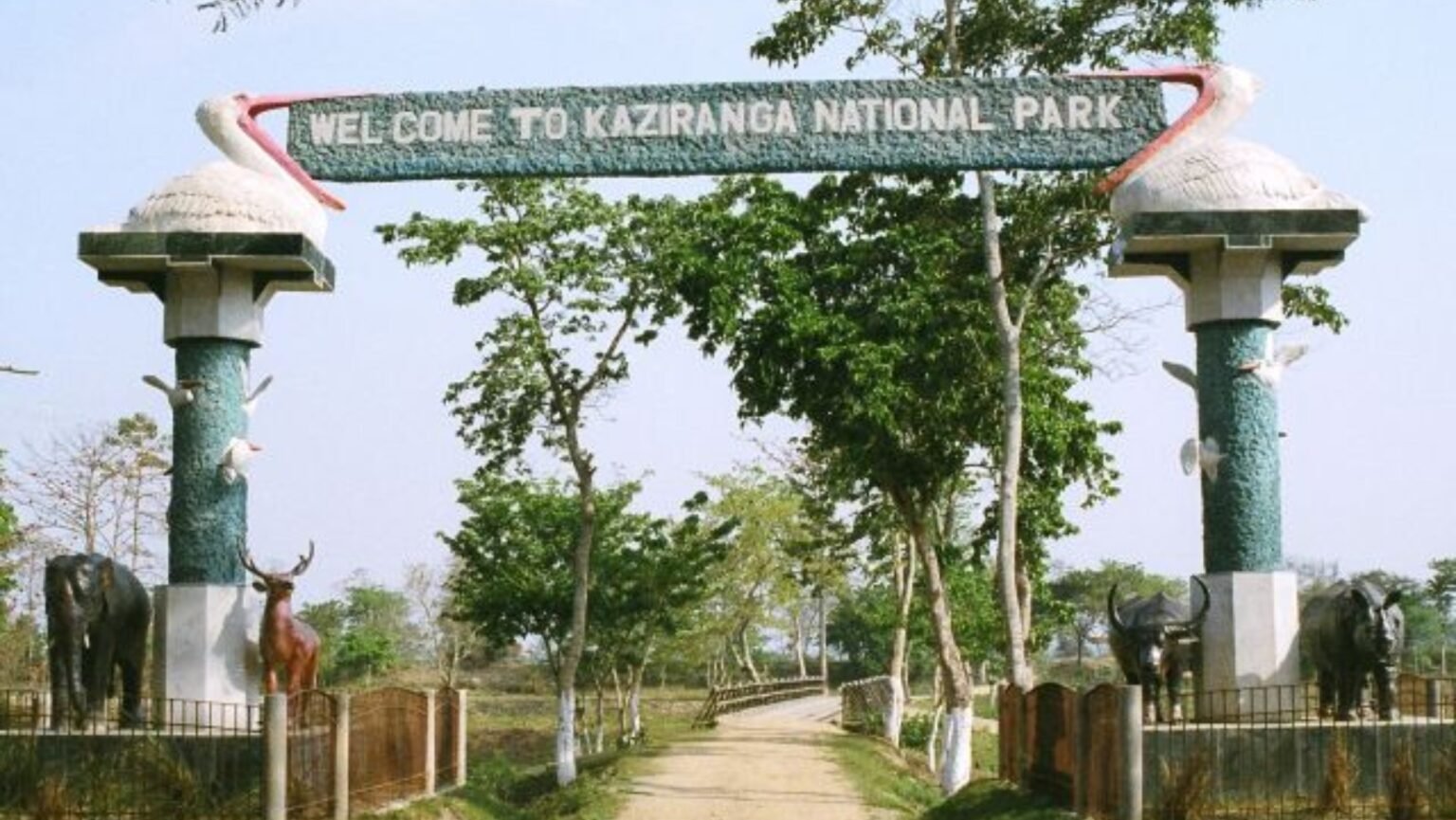Kaziranga National Park is a world-renowned UNESCO World Heritage site in Assam, India, renowned for its one-horned rhinoceros, rich biodiversity, vibrant local culture, and thriving ecotourism industry.
Majestic, wild, and awe-inspiring, Kaziranga National Park is a sanctuary where endangered species roam free and nature’s rhythms rule the land. Recognised as a premier wildlife destination, it offers an immersive experience, including jeep and elephant safaris, bird-watching, tea estates, waterfalls, and a glimpse into the soul of rural Assam. The park’s rise from a reserved forest in 1905 to a global tourism hotspot in 2025 is a tale of remarkable conservation and inclusive growth.
Location and Geography
- Located in Assam’s Golaghat, Nagaon, Biswanath, and Sonitpur districts.
- Covers 1,302 sq. km as of the 2025 expansion, and sprawls across the fertile floodplains of the Brahmaputra River, abutting the Karbi Hills.
- Characterised by tall wet grasslands, riverine forests, sandy islands, and over 250 seasonal waterbodies.
- Coordinates: 26.5775°N to 93.1711°E.
How to Reach Kaziranga National Park
Kaziranga enjoys excellent connectivity via road, rail, and air.
- By Air: Nearest airports are Jorhat (112-136 km) and Guwahati (165-192 km).
- By Rail: Furkating Junction (123 km), Jorhat (138 km), and Guwahati (163 km).
- By Road: National Highways NH 37, NH 27, NH 715, NH 2. Regular Assam State buses, cabs, and tourist coaches from Guwahati, Tezpur, Dimapur, and other points.
- Best time to Visit: November to April (closed May–October for monsoons; reopens early for the 2025 festival season).
Key Details:
| Aspect | Details |
|---|---|
| Location | Assam, India, across Golaghat, Nagaon, Karbi Anglong, Sonitpur districts |
| Area | ~430 sq. km (core); UNESCO World Heritage Site |
| Established | 1905 (reserve), National Park from 1974, Tiger Reserve from 2006 |
| Famous For | One-horned Rhinoceros (world’s largest population), tigers, elephants, wild buffalo, swamp deer |
| Habitat & Landscape | Grassland, marshland, semi-evergreen forest, riverine floodplains; major rivers: Brahmaputra, Mora Diphlu |
| Best Time to Visit | November to April (cool, dry, best wildlife viewing); closed May to October (monsoon/flood) |
| Safari Zones | Central (Kohora), Western (Bagori), Eastern (Agaratoli), Burapahar |
| Safari Timing | Morning: 5:30–7:30 AM, Afternoon: 3:00–4:00 PM (timings can vary slightly by zone) |
| Entry Fee (Indians) | Approx. ₹100 per person |
| Entry Fee (Foreigners) | Approx. ₹650 per person |
| Jeep Safari (Indians) | ~₹4,200 per jeep (max 5 people) |
| Jeep Safari (Foreigners) | ~₹7,700 per jeep (max 5 people) |
| Elephant Safari | ₹950–₹1,250 per person (Indians); ₹2,050–₹2,500 per person (Foreigners) |
| Popular Tour Packages | 2N/3D from ₹10,900 per person; average 4N/5D–7N/8D packages: ₹12,000–₹35,000 incl. stay/transfers |
| Opening Hours | 7:00 AM to 5:00 PM (safaris run at scheduled slots) |
| Accommodation | Range from budget lodges to luxury resorts near main entry points (Kohora, Bagori, Bokakhat) |
| Major Attractions | Jeep/elephant safari, bird-watching, Kaziranga Museum, tea gardens, local villages |
Additional Notes
- Travel costs vary widely depending on the tour package, accommodation, and transport. Budget travellers can manage under ₹5,000 (excluding travel to Assam), while all-inclusive tours are more expensive.
- The park closes from mid-May to mid-October due to flooding during the monsoon season, so plan accordingly.
- Book safaris in advance, especially for peak season and weekends.
Historical Timeline
From poaching grounds to a conservation triumph, Kaziranga’s history is inextricably linked to the tales of its iconic animals and the people who fought to protect them. Local communities and colonial personalities, such as Mary Curzon, played a pivotal role in its early protection.
Fauna: Wildlife and Birds
Kaziranga is globally revered for housing over two-thirds of the world’s population of Indian one-horned rhinoceroses (2,613+ in 2025). The park also features:
- Tigers (the highest density among Indian reserves), wild Asiatic buffaloes, Asian elephants, swamp deer, and leopards.
- Over 500 species of birds, including the greater and lesser adjutant storks, pelicans, eagles, and rare migratory ducks.
- Ganges river dolphins and other rare aquatic fauna.
- Kaziranga has extensive reptile and amphibian populations, making it one of India’s richest biodiversity reserves.
Flora: Landscape and Vegetation
- Wet alluvial tall grasslands are interspersed with marshes and open pools.
- Semi-evergreen forests, dense elephant grass (the famous “Kaziranga grass”), and patches of tropical moist broadleaf forest.
- The unique grassland-woodland mosaic persists due to regular monsoon flooding and fire, an ongoing ecological process.
Local Culture and Community
The ethnic mosaic around Kaziranga comprises Assamese, Karbi, Mising, and tea tribe communities, each contributing to the park’s culture and cuisine. Their festivals, folk music, handicrafts, and daily life enrich the visitor experience. Conservation activities often partner with local people, supporting sustainable livelihoods and eco-tourism.
Top Tourist Attractions in and around Kaziranga
Kaziranga isn’t just about wildlife; there’s plenty for nature lovers, history buffs, and culture seekers.
- Wildlife Safaris: Jeep and elephant safaris in the park’s five ranges (Central, Western, Eastern, Burapahar, and Northern).
- Kaziranga National Orchid Park: A sprawling, 6-acre collection of rare and beautiful orchids.
- Tea Gardens: Hathikuli and Borchapori estates reflect Assam’s tea heritage.
- Kakochang Waterfall: Picturesque natural cascade, ideal for picnics.
- Ethnic Karbi Village: For local culture, crafts, and food.
- Majuli Island: The world’s largest river island, rich in Vaishnavite culture.
- Hollongapar Gibbon Sanctuary: Home to India’s only apes, the hoolock gibbons.
- Panbari Reserve Forest, Jatinga, Sibsagar, and the historical ruins nearby.
List of Key Attractions in Kaziranga

Tourism Economy and Revenue
- Tourism is a crucial source of income for thousands of families in the Kaziranga region.
- Local eateries, homestays, shops, and transport providers benefit directly; community partnerships and government efforts promote sustainable growth.
- A significant “leakage” of tourism spending occurs, but local initiatives are working to retain more value within the villages.
Travel Tips
- Pre-book safaris: Book jeep and elephant safaris in advance to avoid disappointment during peak tourist months.
- Local Guides: Always use registered guides for an immersive and safe experience.
- Respect nature: Obey park rules, avoid plastic, and maintain a safe distance from wildlife.
Recent News and Developments (2025)
- Early Reopening: For the 2025–26 season, the park will reopen early, particularly for Durga Puja tourists, with restrictions in place to protect wildlife.
- Major Expansion: Kaziranga will add 47,306 hectares as its sixth extension, thereby strengthening biodiversity conservation; however, ten villages have been excluded from this plan.
- Tourism Boom: A record 406,564 visitors in 2024–25 (including 17,693 international tourists), quadruple the number from a decade ago.
- Revenue Impact: Revenue reached ₹10.9 crore in 2024–25, underpinning the livelihoods of local guides, hotels, craftspeople, and service providers.
- Centenary Celebrations: Upcoming celebrations for legendary Assamese musician Bhupen Hazarika, closely tied to the park region.
Conservation Challenges and Future
Kaziranga’s conservation efforts have faced challenges, including poaching, floods, highway traffic, tourism pressures, and the need for habitat expansion. Ongoing projects focus on anti-poaching efforts, establishing new wildlife corridors, wetland restoration, and community-based eco-tourism initiatives aimed at promoting mutual prosperity.
FAQs About Kaziranga National Park
What is Kaziranga National Park most famous for?
Kaziranga is world-renowned for its population of Indian one-horned rhinoceroses, the largest in the world, as well as its rich wildlife and birdlife.
When is the best time to visit Kaziranga?
Peak season runs from November to April; the park is closed during the monsoon from May to October.
How can tourists reach Kaziranga National Park?
It’s accessible via road from Guwahati, Jorhat, and Tezpur; by train to Furkating; and by air via Jorhat or Guwahati airports. Cabs and state buses serve all major cities.
What are the entry fees and safari charges?
Safari fees and park entry vary by season and nationality. Recent (2025) data should be checked on the official Kaziranga NP site or local tour operators.
What are other major attractions near Kaziranga?
Apart from the core wildlife experience, tourists can visit Kakochang Waterfalls, the Orchid Park, Assam’s tea gardens, Karbi villages, Hollongapar Gibbon Sanctuary, and Majuli Island.
How does tourism benefit local communities?
Tourism generates significant revenue for Kaziranga, supporting jobs in guiding, hospitality, crafts, and conservation.
Is Kaziranga safe to visit?
Yes, Kaziranga is safe with proper guidance, provided visitors follow the park’s rules and regulations. Safaris are conducted with registered guides and staff.
